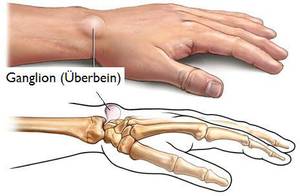Synovial cyst (Ganglion)
Ganglia are round bulging elastic nodes in the vicinity of joints (frequently the wrist) and tendon sheaths. Because of their swelling consistency, ganglia are also commonly referred to as “cysts”. Sometimes ganglia are the result of accidents, but usually they are real, always benign neoformations in terms of an evagination of the articular capsule. The pain depends on the size of the ganglion and the proximity to tendons, nerves and joints. Thus, the complaints are of a weakness in the wrist area, dull pain or even paralysis.
Ganglia can occasionally disappear on their own. An operation is indicated if the ganglion bothers the patient for cosmetic reasons or if the patient is sensitive to the pain. Previously, ganglia were crushed or dug out, and occasionally cortisone injections were used. All these treatments share the disadvantage that sooner or later the ganglion will regenerate, because with these methods the covering membrane is not removed. Thus, the radical operative removal is the method of choice for treatment of ganglia.
The surgery takes place under regional anesthesia, and the ganglion is worked free and removed through a small skin incision made directly above the node, while protecting the blood vessels and nerves. Afterwards, the hand should be taken care of for several days, and light activities can be resumed after 2-3 days, while heavier stresses can be added after about 2-3 weeks. In about 10 – 15 % of cases, even with radical surgery, you may see the ganglion regenerate after a few months or even after a few years, so that another operation is required.


